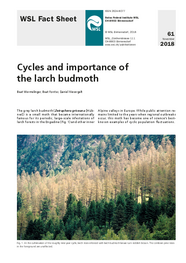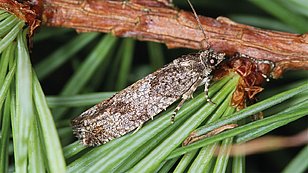Cycles and importance of the larch budmoth

Beat Wermelinger, Beat Forster, Daniel Nievergelt
Wermelinger B., Forster B., Nievergelt D. (2018) Cycles and importance of the larch budmoth. WSL Fact sheet 61. Birmensdorf: Swiss Federal Institute WSL. 12 p.
Brief summary ¶
The grey larch budmoth (Zeiraphera griseana [Hübner]) is a small moth that became internationally famous for its periodic, large-scale infestations of larch forests in the Engadine and other inner Alpine valleys in Europe. While public attention remains limited to the years when regional outbreaks occur, this moth has become one of science’s bestknown examples of cyclic population fuctuations.
The first historical mention in Switzerland of a "disease" that turned extensive larch forests yellow-brown dates from 1820 in the municipality of Ardon in Valais (Coaz 1894). In the mid-20th century, when tourism in Switzerland slowly started picking up again after the Second World War, another larch budmoth outbreak was in full swing. Consequently, he tourism industry in the Engadine pushed for the application of DDT, considered a wondrous new insecticide at the time, to treat the unsightly forests.. In 1948, the pressure to apply insecticides set in motion a long-term study spanning six decades. In the course of this ongoing study, the larch moth changed in public and scientific perception from a mere pest to a ecosystem engineer and fascinating topic of study.
Contact ¶
Links ¶
Related WSL Fact sheets ¶
Order a WSL Fact Sheet ¶
Send orders to: e-shop(at)wsl.ch
Please note that the order quantity for fact sheets is limited to 30 copies. Any duty costs for shipping abroad must be paid by the recipient. Larger orders are only possible on request and against payment of a contribution towards expenses (e-shop(at)wsl.ch).
Imprint ¶
Managing Editor ¶
Martin Moritzi
Swiss Federal Institute WSL
Zürcherstrasse 111
CH-8903 Birmensdorf
martin.moritzi(at)wsl.ch
Publisher ¶
Swiss Federal Institute WSL
Zürcherstrasse 111
CH-8903 Birmensdorf
The WSL is a research institute of the ETH Domain.
Concept ¶
The Merkblatt für die Praxis (ISSN 1422-2876, digital ISSN 2296-4428) summarises key findings from WSL research and provides guidelines for best practice. The series is aimed at forestry and nature conservation groups, authorities, schools and interested laypersons.
French editions are published in the series Notice pour la practique (ISSN 2813-6071). Italian and English editions appear occasionally in the series Notizie per la pratica (ISSN 1422-2914) and WSL Fact Sheet (ISSN 2624-8069).

